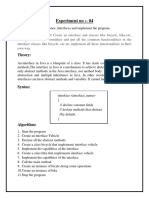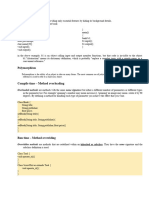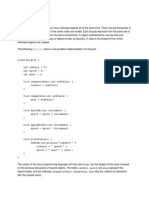0% found this document useful (0 votes)
21 views6 pagesInterfaces
A Java interface is an abstract type that defines a blueprint for class behavior, containing static constants and abstract methods. It enables abstraction, multiple inheritances, and loose coupling in Java, while differences between classes and interfaces include instantiation, method implementation, and access specifiers. The document provides examples of interfaces and their implementation in classes, demonstrating multiple inheritance through interfaces.
Uploaded by
sufiyapraveen01Copyright
© © All Rights Reserved
We take content rights seriously. If you suspect this is your content, claim it here.
Available Formats
Download as PDF, TXT or read online on Scribd
0% found this document useful (0 votes)
21 views6 pagesInterfaces
A Java interface is an abstract type that defines a blueprint for class behavior, containing static constants and abstract methods. It enables abstraction, multiple inheritances, and loose coupling in Java, while differences between classes and interfaces include instantiation, method implementation, and access specifiers. The document provides examples of interfaces and their implementation in classes, demonstrating multiple inheritance through interfaces.
Uploaded by
sufiyapraveen01Copyright
© © All Rights Reserved
We take content rights seriously. If you suspect this is your content, claim it here.
Available Formats
Download as PDF, TXT or read online on Scribd
/ 6





















































































